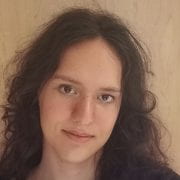Violet Mayne
Research Interests
Machine learning, explainable AI, and robot vision
Presentations
- “An Ensemble-Based Approach for Sample-Efficient Deep Reinforcement Learning from Self-Demonstration” (poster) – AgriFoRwArdS CDT Annual Conference 2024: Robots in Action [July 2024] – Norwich, UK.
- “Beyond 2D images” (oral) – AgriFoRwArdS CDT Summer School: Robotic Phenotyping [July 2024] – Wageningen, The Netherlands.
- “Coastal Surveying with a Hyperspectral Camera” (poster) – AgriFoRwArdS CDT Summer School: Robotic Phenotyping [July 2024] – Wageningen, The Netherlands.
- “Automating the Clock Drawing Test with Deep Learning and Saliency Maps” (oral) – EPIA Conference on Artificial Intelligence 2024 [September 2024] – Viana do Castelo, Portugal.
About me
My name is Violet, I am originally from Brighton, and I am joining the CDT in 2023. My primary research interests are in machine learning, explainable AI, and robot vision. Currently I am particularly engaged with deep feature extraction. Prior to joining the CDT, I studied an MComp (Integrated Master’s in Computing Science) at the University of East Anglia where I will be returning to complete my PHD.
I chose to join the CDT because of my interests in machine learning research intersecting with robotics and how this can have a profound impact on the challenges currently facing agricultural production. I specifically wanted to study my PHD at UEA due to its expertise within the context of the CDT principally being in computer vision and artificial intelligence which I have particular interest in.
MSc Project
An Ensemble-Based Approach for Sample-Efficient Deep Reinforcement Learning from Self-Demonstration
Deep reinforcement learning is an important field within autonomous robotics. This project aims to implement a proposed ensemble-based model for deep reinforcement learning and compare it with a set of established algorithms in a series of simulated robotic environments. To ensure portability, this will be implemented using the unified structure of the Stable-Baselines3 library.
PhD Project
Surveying the Agricultural Landscape using a hyperspectral camera
In the context of the AgriFoRwArdS CDT (students are funded in the area of Agri-food robotics), computer vision technology plays a crucial role in a multitude of sectors, from agriculture to coastal monitoring and often relies on images captured from RGB cameras. Hyperspectral cameras, however, capture much richer information often not visible to the eye including both spatial and spectral information. The additional information will enhance substrate identification, object detection, object tracing, etc in variable lighting and will also possibly help when images are adversely affected by shadows and glare. The application of hyperspectral cameras in a new environment such as coastal surveying presents challenges but also potential high rewards. Our project, in collaboration with Living Optics who develop such cameras and the Centre for Environment, Fisheries and Aquaculture Science (CEFAS), who will provide the case study in terms of coastal surveying tasks will help us understand how this new technology can be applied in the real world. This timely research will provide a pioneering step towards increased accuracy and efficiency in sectors reliant on coastal surveying.
The project will follow a comprehensive, hands-on research approach. The student involved will undergo training in hyperspectral camera use and in the data they generate. They will work closely with CEFAS to produce an annotated image set for a number of their coastal surveying challenges. The research will take place both at the lab and in the field, offering a diverse and enriching experience. The developed hyperspectral systems will be benchmarked against the existing RGB workflow used by Cefas.
In addition to gaining experience in cutting-edge computer vision research, the student will develop a robust set of skills in several key areas. They will receive training in the fundamentals of hyperspectral cameras and get hands-on experience with field deployment of those. Through the development and implementation of algorithms, they will hone their programming and data analysis skills. They will also be exposed to interdisciplinary collaboration, working closely with professionals from agritech, geophysics, ecology, and computational science sectors. Their scientific research skills will be enhanced through the production of academic papers and contribution to public domain source code. This project offers a unique springboard for a future inter-disciplinary career in the AgriFoRwArdS area, providing a rich blend of theoretical knowledge and practical, industry-relevant experience.
Join us as we redefine the frontiers of computer vision technology, paving the way for more accurate, efficient, and reliable environmental surveying solutions. Your participation could help shape the future of agricultural and coastal monitoring systems, making a lasting impact on these crucial sectors.
Violet’s PhD project is being carried out in collaboration with Living Optics and Cefas, and under the primary supervision of Prof.Graham Finlayson

